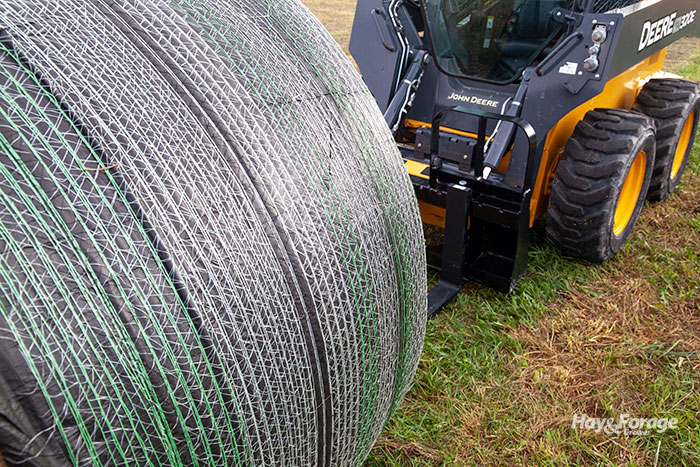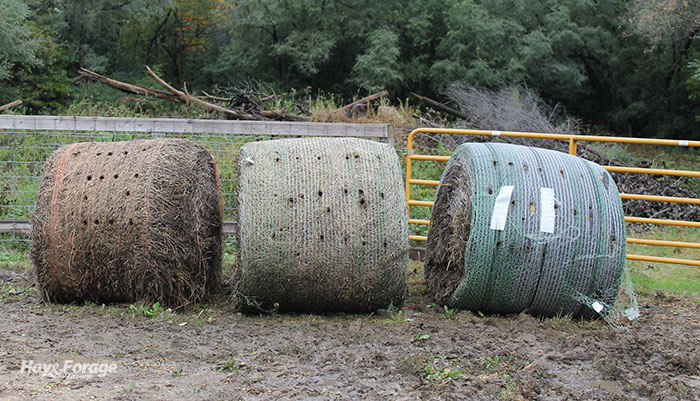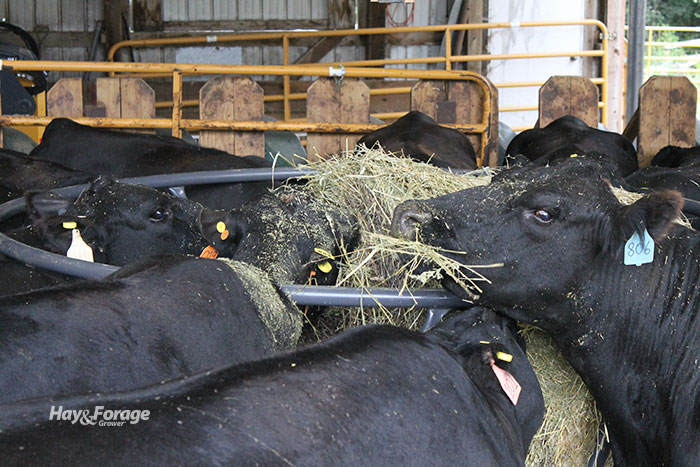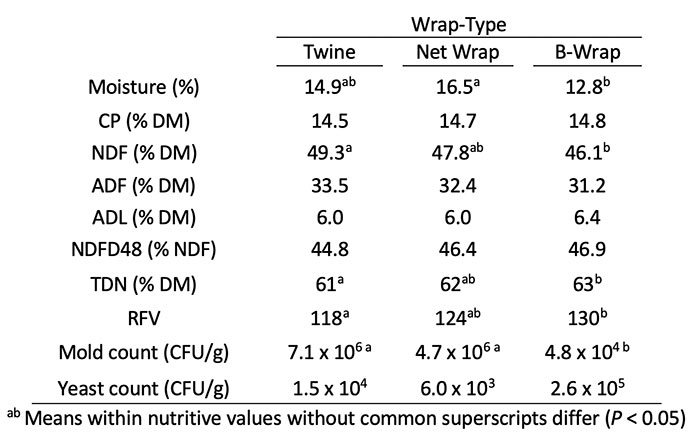
Large round bale storage. Much has been written and spoken about the virtues and inadequacies of various storage options. Most often, the debate comes down to building a hay barn or not.
Although a lot of round bales are stored within or at least under the confines of a building, far more bales are left to coexist with Mother Nature.
The popularity of net wrap, attention to bale orientation, and providing a base that is well drained has helped to alleviate some of the weather losses inherent with outdoor round bale storage. Still, it’s hard to match the minimal quality losses obtained with hay stored under a roof. Or is it?
A breathable bale wrap, marketed as B-Wrap, has been available for several years. The breathable wrap is applied at baling and is designed to shed precipitation and allow water vapor to escape from the bale through small pores. This latter feature eliminates the condensation problems associated with plastic film.
Recently, Extension Specialist Krishona Martinson and her research team at the University of Minnesota examined changes in dry matter losses and forage quality from bales bound in twine, net wrap, and B-Wrap after being stored outdoors for an extended period. Binding time and the economics of the binding materials were also determined.
The round bales were stored on pallets for one year with approximately 5 inches between each bale.
The time that binds
At 56 seconds, twine required the most time to bind a bale. B-Wrap was intermediate at 28 seconds, while net wrap required the least amount of application time at 18 seconds. Time to bind each bale started when the tractor paused to wrap the bale and ended when the bale was ejected from the baler.

Bales differed over time
Although the bales were harvested at the same moisture, twine and net-wrapped bales began to show higher moisture concentrations than B-Wrap bales at 90 days. After one year in storage, the B-Wrap bales were at the same moisture as they were at harvest (10%). The net wrap and twine bales contained 27% moisture after one year.
The twine bales lost 7% dry matter (DM) during storage while the net-wrapped bales lost 5%. B-Wrap bales didn’t lose any dry matter during storage (Figure 1).
Figure 1. Bale moisture in the zero to 6-inch layer of alfalfa large round bales stored outdoors and bound with twine, net wrap, or B-Wrap for 365 days

Changes in forage quality among the binding types were observed beginning at 180 days in storage. After one year, nonstructural carbohydrates (NSC), neutral detergent fiber digestibility at 48 hours (NDFD48), and relative feed value (RFV) were greater for the B-Wrap bales compared to the twine-tied bales. The B-Wrap bales proved to be superior at inhibiting moisture penetration.
Comes at a cost
The researchers estimated the cost per bale when bound with B-Wrap at $8.33. This compared to net wrap and twine with estimated costs of $1.17 and $1 per bale, respectively.
Bale value was calculated using bale weight, RFV ($1.28 per point), the material costs of the wrap types in excess of twine, and excluded round baler equipment costs and wrapping time. Starting at 180 days of storage, B-Wrap bales had a greater individual bale value compared to net wrap and twine-bound bales by at least $10.84 (Figure 2).
Figure 2. Bale value ($ per bale) of alfalfa hay stored outside for 365 days and bound in either twine, net wrap, or B-Wrap

The animals said . . .
After 16 months of storage, the round bales were fed to Angus cow-calf pairs. During each 48-hour feeding period, three bales, one from each wrap type, were delivered to skirted tombstone round bale feeders. Each day, hay waste was collected and the area was scraped clean to minimize contamination with manure.

At the time of feeding, NDF was greatest in the twine-tied bales compared with those wrapped in B-Wrap. The net-wrapped bales were intermediate between the twine and net wrap (Table 1). Twine-tied bales were lower in both total digestible nutrients (TDN) and RFV compared to B-Wrap. The net-wrapped bales were again intermediate.
Table 1. Bale moisture, forage nutritive values, and mold and yeast counts of alfalfa hay stored outdoors for 16 months and wrapped in twine, net wrap, or B-Wrap

Twine tied and net wrap bales had higher mold counts compared with B-Wrap (Table 1). Beef cow DM intake during the first 24 hours was negatively associated with the mold content of the hay.
Beef cow DM intake at the end of 24 hours was greater from the B-Wrap bales (17.9 pounds per cow) compared with the twine bales (9.3 pounds per cow). Intake of the net-wrapped bales was intermediate between the B-Wrap and twine-tied bales.
There were no significant differences in hay waste between the wrap types. The mean total hay waste was 2.2%, 2.5%, and 2.9% for hay bound in twine, net wrap, and B-Wrap, respectively. According to Martinson, the relatively small waste percentages could be a result of feeding under shelter, daily scrapping, and/or adding a bottom plate to the feeders.
This research confirmed the superior preservation properties of B-Wrap. From an economic perspective, the additional cost of B-Wrap is most easily recouped if bales are stored outside for six months or more.
B-Wrap is marketed by Tama USA and it is only available for John Deere 7 Series, 8 Series, and 9 Series round balers that are equipped for net wrap application.
To read about additional B-Wrap research, click here.

